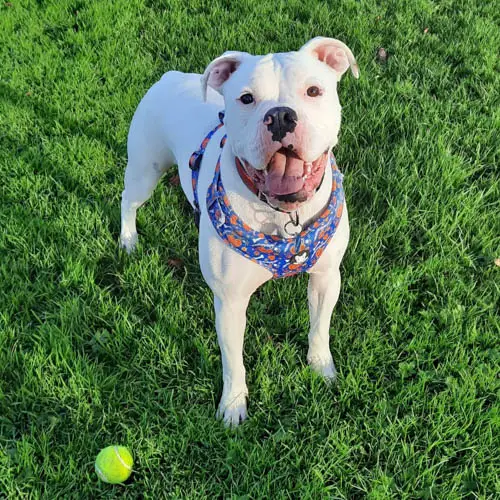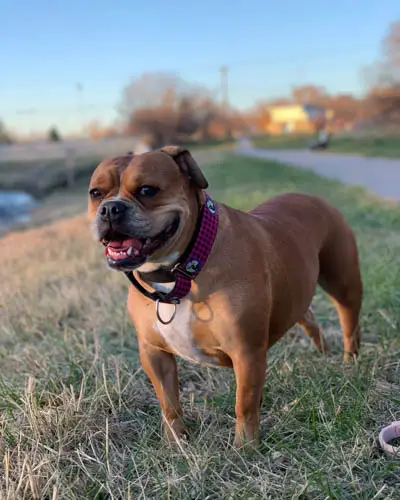Do not get confused if you see an English Bulldog appearance but a Boxer resemblance because the Valley Bulldog is a cross of those two breeds.
These dogs have a sturdy and muscular build with wrinkled faces. Their broad shoulder and chest are also noticeable. They are low-maintenance and only have average shedding. Plus, they enjoy playing and outdoor activities.
If you find Valley Bulldogs interesting, continue reading to learn more about them.
What’s a Valley Bulldog Dog?
Valley Bulldogs are also known as Bull Boxers and a cross between the English Bulldog and the Boxer. They are known for being big, muscular, and very strong dogs. They were first bred in Annapolis Valley, Nova Scotia, Canada. They are a proper blend of gentle behavior and strength.
This English Bulldog Boxer mix is mentioned in records in the mid-1900s, while they may have been around longer than that. Breeders mixed the two parent breeds to create a friendly and active companion dog and minimize health problems.
Interesting: 13 Types of Bulldog Breeds & Their Differences
These dogs were also developed to protect rural properties and catch livestock. They remain excellent guard dogs today, which inherited the suspicious of strangers and alertness of Boxers.

This mixed breed is recognized by various organizations, such as:
- (ACHC) American Canine Hybrid Club
- (DBR) Designer Breed Registry
- (DDKC) Designer Dogs Kennel Club
- (DRA) Dog Registry of America, Inc.
- (IDCR) International Designer Canine Registry
- (IOEBA) Olde English Bulldogge Association
What does Valley Bulldog look like?
The majority of Valley Bulldogs have the facial features of English Bulldogs. They usually have a broad head, short to medium-sized muzzle, and rounded eyes. They look like either the shorter version of Boxers or the taller version of the English Bulldogs.
The dogs’ sturdy, muscular build gives them the advantage when protecting their family or owner’s property. Most of them come with the Bulldogs’ prominent skin folds ad loose skin. The coat is usually short, smooth, and soft in white with black, red, fawn, tan, or brindle.
Valley Bulldog Temperament
When it comes to temperament, Valley Bulldogs have an excellent character. They get along well with humans (adults and children) and other breeds of dogs when socialized properly and if owners understand how to be pack leaders.
This English Bulldog Boxer mix can be very gentle and calm. However, they can suddenly act playful and silly. They love to be around their owners and sometimes clown around. Since they are intelligent dogs, their owners can easily teach them many things.
They bark at sounds or people they do not recognize as excellent watchdogs. So, they tend to be a little aggressive when taking responsibility for guarding the property of their owners at night. With the English Bulldog’s gene, they can be clumsy at times. They do not do well in excessive heat or cold, so they should be kept indoors during nighttime.
Are Valley Bulldogs good family dogs?

Yes. Valley Bulldogs have ease of bonding with almost everyone, making them perfect for the families. They are very low maintenance and clean by nature, making them a great addition to the family. They are also a fantastic companion for active kids with high energy levels. These dogs assume guardianship and responsibility for keeping children safe.
On the other hand, these dogs do best in familiar with older children. Since they do not know their strength or size, they easily knock small children down due to excitement. They are not aggressive around children; they are just too excitable to be careful and well-behaved around them.
How big do Valley Bulldog get?
Even they have full-grown, Valley Bulldogs remain medium-sized dogs. Once they reach the adult stage, they can reach up to 30 to 63 centimeters (12 to 15 inches) at the shoulder. They are about twice as big as Snorkie dogs.
How much does Valley Bulldog weigh?
Since Valley Bulldogs are medium-sized dogs, they weigh between 22 to 56 kilograms (50 to 125 pounds). These dogs do not need much space, making them ideal for people living in condominiums or apartments.
Does Valley Bulldog shed?
This English Bulldog Boxer mix sheds above average. While it is a natural hair growth cycle process, the frequency and amount of hair loss depend on their health status. Those who do not like vacuum cleaning have to reconsider having a Valley Bulldog in their living area.

How often should you bathe a Valley Bulldog?
Thanks to their short and stiff coats, Valley Bulldogs are low-maintenance fur buddies. They do not require frequent baths. Owners should bathe them only once or twice a month.
That frequency will prevent stripping of their coat’s natural oils. If owners feel these dogs are getting too smelly or dirty between baths, they can wipe them down using a wet cloth.
The dogs’ skin folds require attention during maintenance sessions. These folds are found on the female dogs’ belly, tail area, face, and lady parts. The areas within these folds require thorough and regular cleaning and drying to prevent any skin infections. Since skin infections can flare up easily and quickly, owners should be cautious of it.
Do Valley Bulldog bark a lot?
While Valley Bulldogs are non-aggressive dogs, they bark a lot at noises or people they are not used to. This characteristic makes them excellent watchdogs. If owners are not comfortable with excessive barking, they can minimize it with early training.
Is Valley Bulldog hypoallergenic?
Even if Valley Bulldogs have low to average shedding, they are still not hypoallergenic. So, people with allergies need to reconsider having them at home.
Is Valley Bulldog easy to train?

Those who want to train Valley Bulldogs should know that these dogs are very strong. They are Mastiff types, so owners must be very dominant when dealing with them.
One of the best things about these dogs is that they are highly intelligent. So, they can be quickly crate-trained. They disobey to walk on a leash at first since they may be stubborn sometimes. However, displaying patience will eventually provide good results.
Once Valley Bulldogs are correctly trained, they become non-aggressive and an excellent playmate for other animals and children. Owners should offer them attention and affection because they crave them. They also become the happiest when they are with their owners. Failure to provide give them the necessary attention and love causes them depression.
While these dogs adapt well to indoor life, they still require some amount of exercise to stay fit and healthy. A few training principles help set these dogs up for success. Following these rules will make them easy to train.
1. Keep the Training Short.
It is recommended to keep the training sessions around 15 to 20 minutes. By doing so, their attention is being maximized. A 15-minute session per day is an excellent mental exercise. If the training exceeds 20 minutes, the dogs may experience boredom or frustration.
2. Keep the Training Fun.
If owners want to keep their Valley Bulldogs engaged, the training should be fun. However, dogs should not confuse fun with excitement. That is because if they are excited, keeping them focused is difficult. Owners should not overexcite their dogs. Instead, make the entire activity fun.

3. Keep the Training Consistent.
Providing Valley Bulldogs consistent training routine builds great skills. It also reinforces their wanted behaviors. A single solid training session daily pays off huge in the dogs’ obedience levels.
4. Keep the Training Positive.
Owners should always keep the training sessions positive because they respond well to positive reinforcement training. Once they display wanted behaviors or complete a challenge, they should be rewarded.
Owners should never shout, punish, or hit the dog while training. This will make the training ineffective and lead to behavioral issues like stress, fear, and anxiety. If they get frustrated while training their dogs, they should take a break instead.
5. Keep the Training Going.
Training is a daily, lifelong activity. It does not end after the potty training is done. Consistency in training reinforces the wanted behaviors and allows the owners to solidify their bond with the dogs.
6. Keep the Dogs Social.
Socializing is as critical as learning basic commands and obedience. If Valley Bulldogs are well-socialized, they less likely to display signs of aggressiveness. It is recommended to bring them to different places to meet other pets, kids, people, and dogs.
Owners should also introduce them to different environments, smells, and sounds very early. If they are more socialized, they are less likely to develop unwanted negative behaviors.

Valley Bulldog behavior problems
Valley Bulldogs are very sweet with a gentle, willing, and kind temperament. If properly trained and socialized, they are excellent companions for humans and other dogs and pets. Their wonderful personality brings joy to the whole family as their gentle and calm nature quickly turns to goof around and playfulness.
However, Valley Bulldogs also display behavior problems, and there are several reasons for these problems. Some of the reasons can be boredom, stress, or lack of attention. Other things that can cause behavior problems among Valley Bulldogs include:
Health Issues. If they feel ill, experience psychological events, or are in pain, they start acting out. So, it is critical to consult a vet if owners notice a sudden change in their behavior.
Lack of Exercise. Since Valley Bulldogs have high energy levels, it is advisable to exercise daily. With puppies, playtime will help, and walking around is the best for adults. These activities will prevent them from becoming bored and displaying destructive behaviors.
Bad Diet. Valley Bulldogs require a good combination of carbs, minerals, and proteins. If they receive too little or too much of these categories, changes in their activity level occur, especially if starches and sugars are part of their diet.
Lack of Leadership. If owners lack leadership, Valley Bulldogs will think they are their masters. That is why it is critical to show them who the leader is to avoid unwanted behavior. Taking the pack leader role should occur immediately after bringing them home for the first time.
These are some behavior problems that the Valley Bulldogs may be showing:
Aggressive Guarding. When these dogs start guarding their items or particular home areas, they may be aggressive. For instance, if the owner tells his Valley Bulldog to get down the bed, the dog may start growling at him. This action is a clear sign he is beginning to be aggressive.
Passive Aggression. Valley Bulldogs may sometimes test their owners by disobeying them. They do not obey anything their owners say and ignore them to know if they can be dominant. They also test if they can be the head of the house.
Clingy Behavior. These dogs love being with their owners. While it seems a sweet behavior, following them around the house everywhere they go or not letting them out of their sight displays their clinginess. This behavior may be caused by physical or emotional distress.
Excessive Barking. Valley Bulldogs are not known for their non-stop barking. This disturbing and annoying behavior can signify a more serious problem, like pain, emotional distress, anxiety, and attention-seeking.
Begging. When owners give in to their dogs begging for food, it will only reinforce that bad behavior. Plus, if they give them any reaction or yell at their dogs to stop begging, they only keep begging.
Pulling on the Leash. These dogs can be too excited to go out for a walk. It is a misconception that this behavior shows trying to dominate or lead the pack. The truth is they find the outdoors fascinating, and lack of training is to blame.
Playing Too Rough. Some people may think that Valley Bulldogs are hurting or fighting each other when they have not seen them playing with each other before. This behavior is just their way of playing. While they are tough dogs that can handle rough playing, they have to understand that it is not good behavior if they play with other dogs that are not as strong as them.
Chewing. It is entirely normal for dogs like Valley Bulldogs to chew on things. They have reasons why they chew, like relieving stress or teething puppies. However, this behavior may cause unwanted scenarios like chewing on wire or something left on the floor that may cause accidents. Owners should teach them what is okay to chew and what is not.
How much does Valley Bulldog cost?

Valley Bulldogs are in demand nowadays due to their affectionate nature and endearing appearance. Interested individuals should expect puppies to cost from $500 to $1,900 each. They should ensure that puppies are well-screened for serious health issues. That way, they can get the healthiest puppy for the family.
Where to buy/adopt Valley Bulldog Dog
Interested individuals who want to adopt Valley Bulldogs can try the following:
- The Royal Bulldog (Arizona)
- Old Red English Bulldogs Kennel, Inc. (New York and South Carolina)
- Zoe’s Boxer Barn (The Ozarks)
- The Bulldog Club of America Rescue Network
- Green Acres Boxer Rescue
Valley Bulldog Health Issues
This Boxer and English Bulldog mix are usually extremely healthy. However, they are vulnerable to allergies and skin irritations.
That is why proper hygiene is critical because skin folds in the face can easily get infections. Owners should also pay attention to their dogs’ weight since weight gain can lead to several health problems like difficulty breathing.
What is the proper way of grooming Valley Bulldogs?
While Boxer and English Bulldog mix has a short coat, they still shed. On the bright side, they do not need too much grooming. Owners can remove excess and keep the dogs clean by brushing at least once a week. These dogs are affection-loving and love to be around their owners, so they feel happy when groomed.
One of the best things about grooming Valley Bulldogs is that they do not require a bath unless they get too smelly or dirty. Their fur parents can brush them regularly to remove dirt and excess oil from their coats. The brushing must be plenty to keep them clean. If these dogs roll in the dirt or mud, bathing them helps remove the dirt or mud.
Like other dogs, Valley Bulldogs also require regular nail clipping. Since they are active dogs, they may not need their nails clipped as frequently as other dogs. However, owners can do it at home with proper tools or at a groomer’s shop if they already need clipping.
When cleaning between their skin folds, warm water and a clean washcloth will help remove food buildup or debris. Owners must pay attention to the wrinkles on the dog’s head. They also have to dry those folds after cleaning to avoid bacterial growth thoroughly.
What is the ideal diet for a Valley Bulldog?

The Boxer and English Bulldog mix may inherit the hearty appetite of their parent breed. However, it is still best to keep their diet to 3 cups of dry dog food daily. Their fur parents must split the food into two meals a day.
It is recommended to give Valley Bulldogs food free from artificial colors, flavors, and preservatives, particularly if the dog inherits Bulldogs’ sensitive digestive system. The ideal diet for these dogs must be formulated for active, medium-sized dogs.
Since this breed mix can gain weight when overfed, owners must stick to their regular feeding schedule. They should not leave food out during the day. Plus, they should also limit the number of treats.
Like all dogs, their dietary needs change from puppy to adulthood and continue to change as they reach their senior years. Fur parents must ask their vet for recommendations regarding the dog’s diet to make one based on their health, energy, and weight.
Conclusion
Valley Bulldogs are an interesting mixed breed. They are usually sociable and make friends with humans and other pets and animals. They are ideal for active families because of their high energy levels. They do well with older children, especially during playtime.
With proper exercise and training, they become excellent watchdogs. They are also low-maintenance with average shedding, making them ideal for owners who do not want to vacuum their space from time to time.
Fur parents should pay attention to the dogs’ skin folds because they are vulnerable to skin infections that may lead to serious problems if left unattended.
Overall, these dogs are loving, loyal, and adorable companions. They enjoy goofing around and being with their owners. With proper care, love, and attention, they will love you back and protect you.





